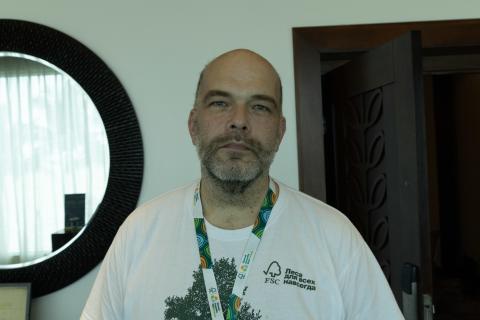FSC Policy for Association in action: for better or for worse?
For the second time in two years, FSC has used its Policy for Association to disassociate from a leading timber trader. We take a close look at the impact and repercussions of the policy.
On 12 February 2015, FSC announced its decision to disassociate from the Danish timber trader Dalhoff Larsen and Horneman (DLH), a long-term FSC member and a prominent trader in timber products from around the world.
The decision was the second of its kind, following an earlier decision by FSC to disassociate from the Danzer Group on 21 May 2013.
Policy for Association: Unacceptable activities
1. Illegal harvesting and trade.
2. Violation of traditional and human rights.
3. Destruction of high conservation values in forests.
4. Significant forest conversion.
5. Use of genetically modified organisms.
6. Violation of ILO Core Conventions.
These decisions were made based on perceived violations of the FSC Policy for Association (PfA) raised by leading international NGOs. According to this policy, FSC will only associate with companies that are not “directly or indirectly” involved in unacceptable activities, such as illegal timber harvesting and trade.
Greenpeace raised allegations against Danzer, whilst Global Witness raised the case against DLH. Both cases centred on African concessions involved in unacceptable activities.
In the case of Danzer, the allegations concerned a concession that was a former Danzer subsidiary. In the case of DLH, the key question was whether the company had shown sufficient due diligence in buying timber from a trader sourcing from Liberian forest areas.
FSC re-associated with Danzer on14 August 2014 based on the company’s fulfilment of FSC’s requirements.
FSC has a fair and legitimate right to protect its brand by not associating with companies involved in unacceptable activities. FSC’s PfA is designed to address this need.
FSC clearly handles cases raised under its Policy for Association seriously and seeks to ensure a fair judgement, putting significant effort into verifying claims and allegations before it makes any decision to disassociate from a company. This is evident from the detailed account of the DLH case that FSC has published.
Nevertheless, it is doubtful whether the policy in its current form serves FSC’s core goal of promoting responsible forest management very well.
Missing proportionality
The PfA has no built-in mechanisms for grading violations or considering proportions. Executive Director of NEPCon Peter Feilberg believes that this is based on an unrealistic notion.
“Companies should apply due diligence to minimise their risk of being linked to unacceptable behaviour. However, due diligence can only reduce the risk to an acceptable level. It cannot eliminate risk completely. The larger the company, the more complex its supply chains and the more high-risk regions it sources from, the bigger the risk that some unknown, unacceptable activity takes place somewhere in their supply chains”, he says.
“Large companies with even the best due diligence system in place will sometimes experience cases where something goes wrong in their supply chain. A good system has built-in mechanisms to identify such cases and improve performance through regular monitoring”.
Stefan Salvador is Director of FSC’s Quality Assurance Unit which is coordinating FSC’s PfA Working Group. He comments: “There is a certain crudeness built into the policy. But usually things are not so clear-cut in reality. We may be looking at a company with a generally high level of responsibility and with some level of failure. The only permissible conclusions under our policy are, however, for the company to be in or out, with no option in between. The PfA Working Group is tasked to reconsider this binary approach.”
In the case of DLH, with today’s knowledge there is little doubt that the company did purchase illegal timber from Liberia. However, at the time when the first reports on illegal activities appeared, the picture was not that clear. In addition, DLH’s trade in Liberian timber constituted a very small part of the company’s total transactions. Although DLH did not react immediately on reports of illegal logging, it ceased buying from the Liberian supplier at the end of 2012. Also, the DLH logs in question were not FSC certified and were not mixed into FSC certified products.
Who is ‘indirectly involved’
One additional aspect might be seen as a strongly extenuating circumstance in the case of DLH: The DLH timber had an export certificate, which was supposed to cover legal origin, traceability and the payment of fees and taxes.
The certificate was independent of the FSC system, but issued by a company that is controlled by an FSC accredited certification body (CB). DLH relied on the certificate as a key part of its due diligence procedure. It seems illogical that FSC disassociates from the company relying on the certificate including all of DLH’s affiliates while there are no sanctions against the CB. An FSC CB is by default strongly associated with FSC.
“In this case, the logic eludes me. In general, there is a lack of clarity on who’s seen as ‘indirectly involved’ in unacceptable activities and who’s not. What sort of links are we talking about? How far downstream in the supply chain can you be and still be heading for a PfA case?” Mr Feilberg asks.
He also notes that since the policy works primarily through a complaints mechanism, it can seem arbitrary which companies are targeted and which are not. Given the extent of illegal timber trade, documented by several NGO investigations over the past few years, it is very likely that additional FSC certificate holders are in violation of the PfA.
“There is plenty of circumstantial evidence indicating this, but it would require an extraordinary amount of resources from FSC to investigate it,” says Mr Feilberg.
Buyers of FSC products also affected
Mr Feilberg explains that the damaging impact of disassociation will often extend to the company’s business relations:
“For a company that has invested heavily in FSC certification and built its key trade relations around this, disassociation is a very severe punishment. And unfortunately, it affects not only the company itself but also its buyers who may depend on supplies of FSC certified material for products that they are contractually bound to deliver”, he says.
Danzer and DLH sold FSC certified products that may be very difficult to replace at short notice. In such cases, the FSC PfA constitutes an important supply security risk factor for companies investing in FSC trade.
A company disassociated from FSC faces three types of sanction: 1) They need to cover the cost of the case, which can be significant. 2) They must pay compensation for any damage at forest level, linked to the trade in question. 3) The legal entity involved and all related entities are excluded from associating with FSC.
The disassociation will typically be far the most costly sanction. Including the company itself and all its related legal entities, it bans all trade in products carrying an FSC claim (FSC certified and FSC Controlled Wood).
Double standards?
“The PfA’s current wording is black-and-white”, states Mr Feilberg. “It literally does not tolerate the slightest relation to any unacceptable activities, even if the company is several links away in the supply chain”.
Mr Feilberg emphasises that the FSC system itself takes a risk-based approach. “The FSC Controlled Wood system requires certificate holders to avoid the sourcing of unacceptable timber by reducing the risk. This is a very sensible approach. There is no guarantee of excluding risk altogether, but an effective due diligence system can have significant impact, and it is in fact the only realistic way to go.”
Mr Feilberg provides the following example: If a company sources timber from Eastern Russia without any precautions, at least 50% will be illegal according to estimates by the NGO Environmental Investigation Agency (EIA).“With an effective due diligence system in place, the risk may be reduced to less than 5 % - a major positive achievement,” he says.
The PfA follows a significantly stricter approach than the one used for certified FSC controlled wood. This can be seen from the following two scenarios:
Scenario A: An FSC Controlled Wood certified company sourcing from a high-risk area finds out that a controlled wood supplier has delivered illegally harvested material. It will typically discover such issues during a field verification, which may take place up to one year after the delivery. As a consequence, the company is expected to exclude the supplier from further deliveries – that is all.
Scenario B: The same company sources exactly the same material as non-certified. It receives reports that the wood is illegally harvested, initiates an investigation and stops sourcing from the suppliers half a year after the first reports that the timber is illegal.
Under scenario A, the company’s certification body will probably conclude that the company has followed the standard by taking required action. Under scenario B, the company runs the risk of a PfA case causing FSC to disassociate from it.
A barrier to positive change?
Disassociation may have adverse impacts on the ability of the FSC system to cause positive change in the most critical forest regions of the world.
“The PfA is becoming - and is perhaps already - a barrier for companies working to create a foothold for FSC in areas notorious for their forest governance problems. These are the areas where FSC can achieve the biggest positive impact”, states Mr Feilberg.
Where there is poor governance, there is a high risk of making mistakes that can result in a PfA case.
FSC certified companies engaging in such areas are already running a major reputational risk. Realising that they are putting their entire FSC business at stake may be the final push to decide not to engage at all.
A perceived threat of disassociation may easily deter FSC certificate holders from entering into those regions or continuing activities there, leaving the scene to rival schemes of lesser quality or to unscrupulous enterprises that may never engage in certification.
Mr Feilberg: “One likely result will be the unchecked expansion of palm oil and soy production at the expense of forests”.
Suggestions for improvement
The current PfA system provides a necessary instrument for FSC to decouple itself from unacceptable behaviour. The problems lie in its current formulation and somewhat arbitrary use and in particular in the use of a single, very severe sanction that can seem disproportionate to the offense. These factors are creating uncertainty and mistrust amongst FSC certificate holders.
The investment and business risks involved are of course no argument for FSC to condone unethical behaviour. But looking at the repercussions for the FSC system itself, it may be justified to look at mechanisms that can complement the drastic action of disassociation.
Unlike the FSC certification system, the PfA does not operate with grading, such as minor and major corrective action requests. A major ‘corrective action request’ might be more appropriate in cases where companies agree to address issues raised under the PfA and to compensate for any damage.
“Disassociation should be the last resort, not the first. I would encourage FSC to explore such options. The revision of the PfA should ensure that it is fair, transparent and consistently applied”, states Mr Feilberg.
A review of the policy is ongoing. According to Mr Salvador, the PfA working group is exploring options of grading sanctions. “When the policy was first adopted, the expectation was that disassociation meant ‘goodbye’ to the company. But the reality is that the disassociated companies have almost immediately set out to address their issues and to re-engage with FSC. The application of the policy needs to reflect that it serves as much an incentivising as a penalising purpose, and in this context, immediate disassociation sometimes appears too severe as the only sanction available. That’s why we are now discussing a two-step approach in the working group, with the option to provide a correction timeline before we take the drastic measure of disassociating from a company,” he explains.
“This may give rise to concerns among stakeholders that the policy will lose its teeth. However, I believe that the industry would perceive even the first step of such a process as a serious measure. Our ultimate goal is to have a wise tool that incentivises positive change on the ground,” concludes Mr Salvador.
Mr Feilberg also suggests incorporating PfA related requirements directly into the FSC system: “FSC might ask due diligence from FSC certificate holders as a part of the certification process. Requiring this from applicants would ensure that it is checked even before they are certified. FSC certification bodies would check that the companies are aware of the policy and have evaluated the risk of violation by related companies. Regular audits would expand the policy’s reach, ensure a more robust system and create a sense of fairness and equal treatment among certificate holders.”
Mr Feilberg: “This may seem like a huge task, but in reality only a small share of certificate holders would likely need to conduct comprehensive due diligence analyses.”
FSC’s National Risk Assessments are providing very useful information for companies that need to evaluate their risk of being connected to unacceptable activities.
Disclaimer: NEPCon was not working with Danzer at the time of their disassociation and has not been working with DLH France, the DLH entity involved in the Liberian timber trade. NEPCon is providing certification services to other legal entities of DLH and engaged with Danzer on provision of LegalSource services subsequent to their disassociation and prior to their re-engagement with FSC.



